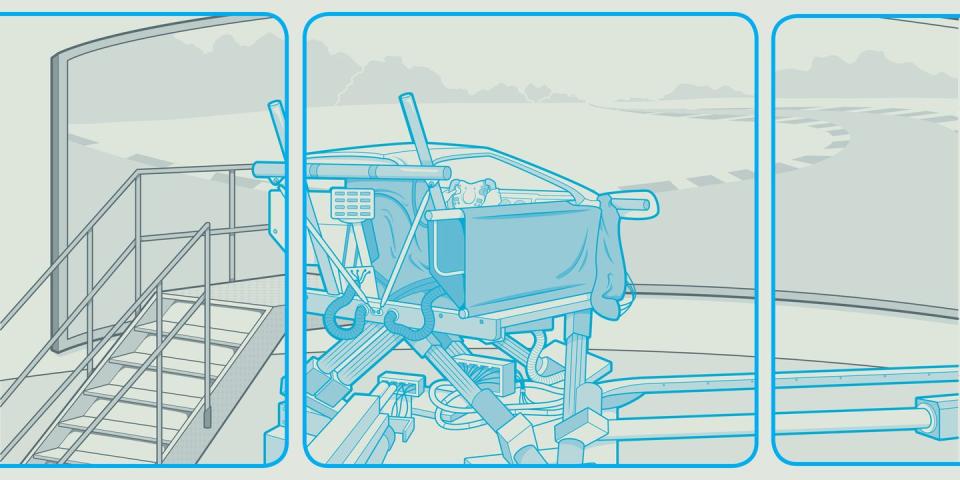You Don't Know the Power of a Modern Simulator Until You Try One

Automakers need to reduce. Reduce emissions, reduce costs, reduce crashes, reduce complexity, reduce development time, etc. In October 2020, GM CEO Mary Barra posted something of a manifesto on LinkedIn stating the company's goals of "zero crashes, zero emissions, zero congestion." There's another "zero" phrase floating around in the automotive world, too: "Zero prototype."
The idea is deceptively simple—all automotive development happens in the virtual world, and no physical cars are built until production begins. There's a lot of debate as to whether or not a true state of "zero prototype" is achievable, but it's an ideal that much of the auto industry is chasing. Even if we never get there, it's worth aiming for. One of the key tools in this quest is the driving simulator.
Last month, the folks at Multimatic—the Ontario-headquartered supplier and racing firm best known for spool-valve dampers and the second-generation Ford GT—invited me to try the company's simulator just outside Detroit. A rare opportunity for a journalist, and a peek behind the curtain for how today's cars are developed.

Built in collaboration with Italian firm VI-grade, one of the two major companies building simulators of this scale, Multimatic's sim is the first of its kind in the U.S. It's an intimidating sight if you're a non-engineer journalist who's about to get strapped into the thing. From the ground up, there's a steel plate covering up three air bearings which create a frictionless surface for the motion platform. Three longitudinal actuators control lateral, longitudinal, and yaw motions and can displace 2.5 meters, a stat that gives this particular system part of its name, DiM250. (VI-grade also offers cable-driven simulators that can generate over four meters of displacement.)
On the base of the motion platform is a hexapod that supports a seating buck. Those six actuators control vertical, pitch, and roll motions, and there's a redundant actuator for yaw motion. So, nine degrees of motion freedom in total. The tripod controls motions up to 8-10 hZ, while the hexapod controls motions of up to 50 hZ. "When you put that whole system together, you get the best of all worlds," says Multimatic engineering VP Michael Gutilla. "You have all the large planar motions for all your driving dynamics, and then a lot of the high frequency content that's put in through the hexapod so you can do ride comfort, and even some off-road maneuvers."
The DiM250 is so large, Multimatic had to build its offices around the rig. Surrounding the motion platform is a wraparound screen and behind it, up two flights of stairs, is a control room where the engineers sit, loading up different programs for the driver and logging data, up to 100 gigabytes a day in telemetry alone. There are three seating bucks that can be placed on top of the rig—one based on the previous Mercedes C300, one based on the previous Ford Escape, and one based on the Ford GT. For my test, Multimatic used the GT buck, as I was driving a virtual GT. The buck sits around eight feet off the ground at rest, so you need to wheel in stairs to actually hop in. Then someone has to wheel the stairs out of the way.
It's an incredibly powerful tool. I'd soon learn just how powerful.

I've played racing games since I was a kid and I've tried out motion simulators a handful of times before. This is nothing like any of that, which is obvious from the moment you strap in.
This buck was configured with a racing bucket with a five-point harness with tensioners on the shoulder belts, and the steering wheel from a GT Mk2. It feels like sitting in a blacked out version of a Ford GT because that's basically what it is, just with a Motec screen in the middle of the cockpit instead of a gauge cluster. The seat was adjusted so I could reach the pedals—I'm only 5'7"—and the steering wheel set all the way at my chest, as in a race car. You wear headphones to get simulated sounds from the machine and to talk to the control room, and they're noise canceling so you don't hear the actuators at work.
I very quickly knew I had a problem. To get acclimated, the engineers had me practice lane changes on an infinitely long highway. After a few on a lower-motion setting that tripped me out a little, motion cueing was ramped up to its max setting, 1:1. The motion of the rig corresponded exactly with real life. So, it moves around a lot. In any sim rig, it's impossible to apply constant g-force to the body, so your sense of speed gets distorted. The first time I hit the brake pedal—which is connected to a hydraulic system to provide realistic feel—I went way too hard without realizing it. The rig moved back way more than I expected. I told the control room that I was starting to feel sick, and the engineers encouraged me to step out of the machine, take a drink of water, and try to regain my bearings. If I kept trying without a break, I was only going to make myself sicker.
Realizing the rarity of this opportunity, I climbed back in. We went straight for the good stuff, a run up and down a b-road near Multimatic's technical center in Thetford, England, not too far from Lotus. I've never driven this particular road, but this job has put me on plenty of English b-roads, and I was astounded at how accurate it felt. We switched between a few different suspension setups on the virtual Ford GT, and the differences in calibration were immediate and obvious. What was great is that you can just swap setups on the fly, so you can get a real A/B comparison you couldn't hope to recreate in the real world.

 Yahoo Autos
Yahoo Autos 